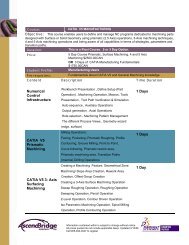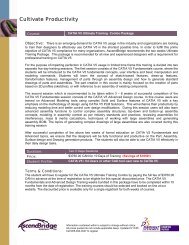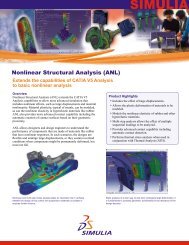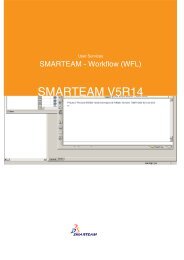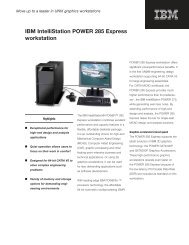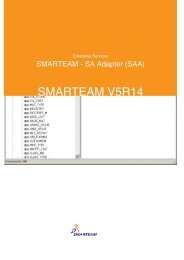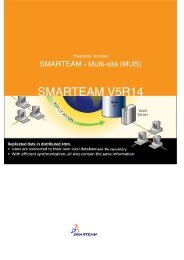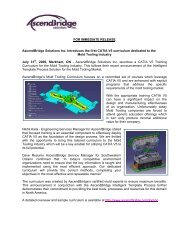Thermal Analysis (ATH) - AscendBridge Solutions
Thermal Analysis (ATH) - AscendBridge Solutions
Thermal Analysis (ATH) - AscendBridge Solutions
You also want an ePaper? Increase the reach of your titles
YUMPU automatically turns print PDFs into web optimized ePapers that Google loves.
SIMULIA<br />
<strong>Thermal</strong> <strong>Analysis</strong> (<strong>ATH</strong>)<br />
Extends the capabilities of CATIA V5 <strong>Analysis</strong> to thermal analysis<br />
Overview<br />
<strong>Thermal</strong> <strong>Analysis</strong> (<strong>ATH</strong>) extends the CATIA V5 <strong>Analysis</strong> capabilities,<br />
allowing designers to understand the thermal behavior of their<br />
designs. The steady-state or transient temperature distribution can<br />
be calculated in response to the direct heating of a surface, the flow<br />
of a fluid past a surface, or the specified temperature of the surface.<br />
The thermal material properties can be temperature-dependent. When<br />
analyzing assemblies, the conductivity across the interface between<br />
contacting parts can be specified.<br />
Product Highlights<br />
• Calculates the temperature distribution in a part or<br />
assembly.<br />
• Determines the steady-state or transient thermal<br />
response.<br />
• Material properties can be temperature-dependent.<br />
• Allows the conduction of heat between parts in an<br />
assembly.<br />
Understanding the temperature variations within a disk brake during braking<br />
is necessary to ensure adequate heat venting. <strong>Thermal</strong> analysis allows the<br />
temperature of the brake to be determined during the braking process.<br />
Temperature distribution for an engine heat transfer analysis
SIMULIA<br />
Features and Benefits<br />
In addition to the functionalities and benefits provided by<br />
Generative Part Structural <strong>Analysis</strong> (GPS), <strong>Thermal</strong> <strong>Analysis</strong><br />
(<strong>ATH</strong>) offers:<br />
<strong>Thermal</strong> analysis<br />
<strong>ATH</strong> allows the temperature distribution in a part or an assembly<br />
to be determined, allowing designers to understand the thermal<br />
behavior of their designs. The calculated temperature distribution<br />
can be used to perform a thermal stress analysis in Nonlinear<br />
Structural <strong>Analysis</strong> (ANL) to study the effect of thermal-induced<br />
stresses and potential fatigue problems that they may cause.<br />
The steady-state capability allows the long-term temperature<br />
distribution to be determined. <strong>ATH</strong> also has the ability to analyze<br />
the transient thermal response, such as the effect of a thermal<br />
shock or a start-up event.<br />
<strong>Thermal</strong> loading<br />
A heat flux can be applied to a point, surface, or volume,<br />
modeling the effect of direct heating. A film condition can also<br />
be applied to surfaces, modeling the effect of a fluid such as<br />
air or water next to the surface. The bulk temperature of the<br />
fluid and the heat transfer coefficient between the fluid and the<br />
structure must be defined. The temperature of parts of the model<br />
can also be specified directly.<br />
<strong>Thermal</strong> materials<br />
For a steady-state analysis, the conductivity of the material<br />
must be defined; for a transient analysis the density and specific<br />
heat is also required. The conductivity and specific heat can be<br />
specified to be temperature dependent, which is common for<br />
many materials. This makes the solution nonlinear and <strong>ATH</strong> will<br />
automatically perform a nonlinear analysis.<br />
<strong>Thermal</strong> analysis of assemblies<br />
A thermal analysis of an assembly can be performed. <strong>ATH</strong><br />
will automatically locate surfaces on adjacent parts and create<br />
thermal contact between them. The thermal conductivity across<br />
these contacting surfaces can be defined so that the surfaces<br />
conduct heat appropriately, depending on the size of the gap and<br />
the temperature at each surface.<br />
Close-up view of the temperatures in the cylinder of an engine<br />
Heat transfer analysis of a pressure vessel<br />
Results interpretation<br />
Contours of the temperature distribution in the part or assembly<br />
can be plotted. For a transient analysis, the temperature<br />
distribution can be plotted at various times during the transient<br />
and then animated. X-Y data can be exported to Excel allowing<br />
the time variation of the temperature at points in the model to be<br />
plotted.<br />
Temperatures in the half section of the pressure vessel<br />
SIMULIA World Headquarters<br />
166 Valley Street<br />
Providence, RI 02909 USA<br />
+1 401 276 4400<br />
E-mail: simulia.info@3ds.com<br />
<strong>ATH</strong>-1208<br />
The 3DS logo, CATIA, and SIMULIA are registered trademarks of<br />
Dassault Systèmes or its subsidiaries. Other company, product,<br />
and service names may be trademarks or service marks of their<br />
respective owners.<br />
Copyright Dassault Systèmes, 2008



